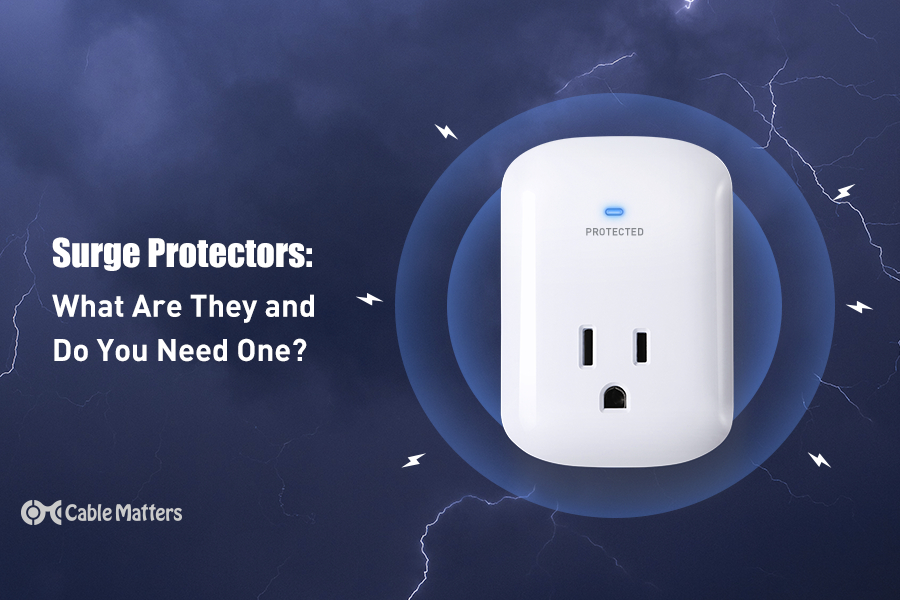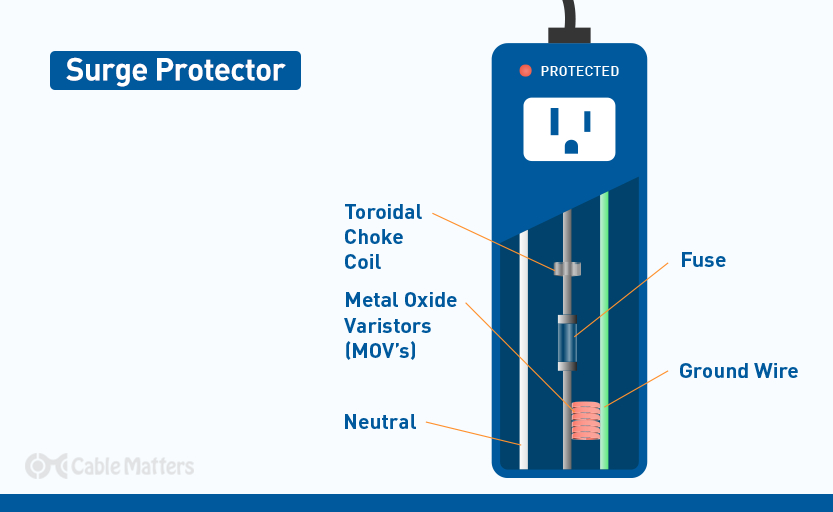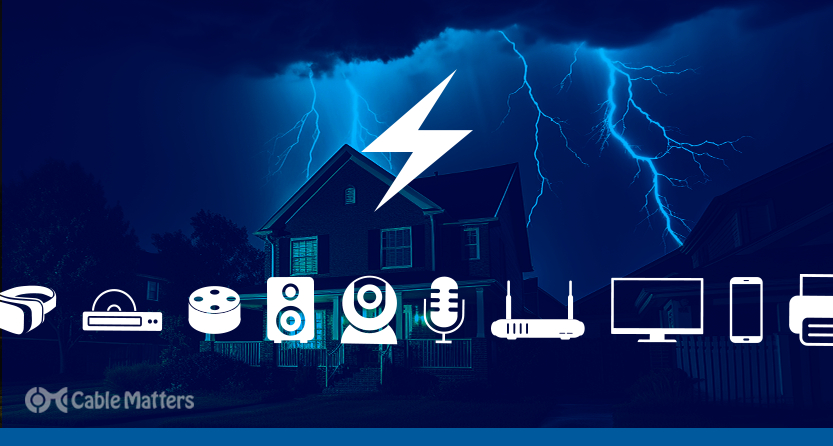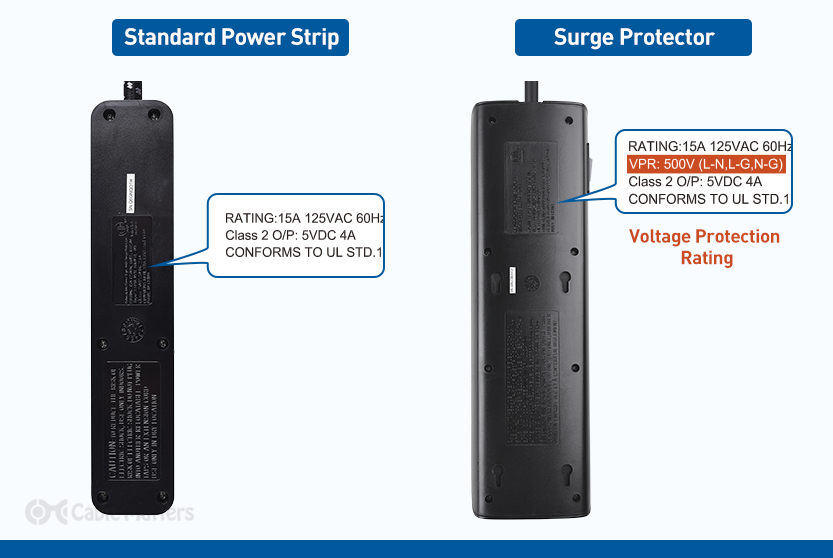
If there’s one thing that you need to be careful of with expensive electronics, it's surges. These transient waves of current, voltage, or power – though typically it’s an overvoltage spike with a short voltage waveform – can damage, degrade, or even destroy expensive electronic equipment in the home, office, or industrial setting if they aren’t adequately protected. If you’re working or playing with a piece of equipment, a home computer, laptop, or TV that’s worth a lot of money, it’s a good idea to protect your devices against power surges.
It’s hard to predict when and where a surge might come from, though. They can be caused by equipment faults, lightning discharges, load switching on the grid, or sometimes something as simple as switching on another electronic device connected to the same grid. This is particularly apparent with large home appliances like heaters and air conditioners, but they can also be caused by smaller devices, too.
In each case, though, the surge is an electronic current, or voltage that’s too strong for another device to handle without taking some kind of damage, so we want to mitigate that. Individual devices can have their own anti-surge protections, but one of the best ways to protect any device, whether it has its own defenses or not, is with a surge protector.
Surge protectors are a range of devices that can be used to limit the transient overvoltage reaching your equipment, thereby preventing any damage from taking place. That lightning strike might blow the surge protector, but it won’t affect your important electronic devices. It manages this by diverting the excess current away from your electronics, often simply to the ground, while reducing the voltage to a safe level.
There are different types of surge protector devices that use different materials and have different levels of effectiveness. Picking the right one isn’t always straightforward, but never fear: With a bit of know-how, you’ll have everything you need to buy the right surge protector to keep your important devices safe and sound.
What Is a Surge Protector?
Surge protectors are specialized electronic devices that are designed to protect other electronic devices from power surges that spike current or voltage in a very short period of time, beyond what the devices are designed to handle. They act as a middle-ground between your devices and the mains power supply, often built like a power strip with a range of plugs to connect your devices to.
Surge protectors can also offer additional protection against electronic magnetic interference and line noise.

To achieve this, surge protectors are usually fitted with metal oxide varistors (MOV), which can absorb the excess current when it surges, protecting the devices you have plugged into the surge protector. Some surge-suppression devices use silicon avalanche suppressor diodes (SASD) instead because they respond much faster. Where a SASD surge protector may respond in just a few nanoseconds, a MOV surge protector might take as long as 30 nanoseconds.
In each case that’s probably fast enough to protect your devices, but for the most sensitive and expensive electronic equipment, it can be worth it to spend more for a SASD device to guarantee faster response times and better protection.
Some commercial and industrial surge protectors use gas discharge tubes. They work slightly differently but achieve the same result of diverting excess current to the ground wire where necessary.
Note: With vital equipment like desktop computers, servers, or NAS drives, it can be worth protecting them with an uninterruptible power supply (UPS). They offer surge protection as well as a battery backup, so you have a short time after a surge or power outage to safely de-power the device, back up anything that needs saving, and shut down the system.
When it comes to adding surge protectors at home, there are a few different product design options to choose from. The most common is a surge-protected power strip. These effectively function as a standard power strip, with a single cable to plug into the mains power, and then a number of plug ports on the strip for powering your devices. Every device plugged into that strip can benefit from the surge protection, though you’ll need a power strip like that for each group of devices you want to protect.
Some more advanced surge protectors offer additional features, like individual power on and off switches for each device. The most advanced surge protectors do this automatically, though. They have the ability to detect when a connected device is turned off, at which point it shuts down power to that device, helping to reduce standby power use from devices, and saving you further on energy bills.
There are even some power surge protectors that have built-in light and motion sensors, so they can power on your devices only when they’re needed, and can power them down when you aren’t around. That can be great if you forget to turn a device off, but also just means you don’t have to manually switch them on and off as needed.
Make sure to set custom delays on surge protectors like that, though. The last thing you want is your TV to turn off halfway through a movie because you’ve sat stock still for the past hour!
If you’re more concerned about power surges from external factors, like an unstable power grid, or from lightning strikes, you might also want to consider a whole house surge protector.

These can act as a first line of defense against major surges, making power strip surge protectors a second line double protective layers. They can also protect important home electronics that are hard-wired into the home circuitry, like garage door openers, HVAC equipment, and major appliances like dishwashers and stoves.
You’ll need a professional to install a whole home surge protector, but if you want the ultimate in protection against external surges, there’s nothing as effective.
How To Choose the Right Surge Protector
There are a lot of different types of surge protectors out there, many with advanced features that might be of interest to you. If they aren’t, though, you can save a lot of money by avoiding them – especially if you’re looking to kit out your home or office with several surge protectors.
The first question to ask yourself when choosing a surge protector, is what are you looking to protect? The value of the equipment you’re placing behind a surge protector should give you an idea of how much you should spend. Devices or appliances which are particularly expensive, costing thousands of dollars, are worth protecting with a robust – and even expensive – surge protector.
Cheaper devices, or those with less importance to your work or home life, can be protected with more pedestrian, more affordable designs.
The next is to consider the joule rating for the surge protector you’re buying. This is the amount of electrical energy that the surge protector can dissipate, so is a good measurement of the effective protection that the surge protector can provide. Affordable, but capable surge protectors will typically have a joule rating of 200-400 and are perfectly fine for protecting everyday items. For small appliances, a joule rating of around 1,000 is preferable, while expensive or sensitive electronics should be protected by a surge protector with a 2,000+ joule rating.
That’s not all you need to consider, though. Response time is also incredibly important with surge protectors. There will always be some measurable delay between the surge happening, being detected, and the surge protector diverting it away to the ground, but some surge protectors are faster than others. Ideally, look for a surge protector that reacts in less than one nanosecond (one billionth of a second). Much more than that and you risk the surge protector allowing some of the surge to get through to your device(s) before diverting it.
Ideally, you want one with a low voltage rating, too. This is the voltage that the surge protector will actuate at, so ideally you want one with a relatively low voltage so that any overvoltage event leads to protection of your devices. For the best protection, look for a surge protector that is rated for 400V or less.
Beyond the protective measures the surge protector offers, you also need to consider practical aspects, like how many outlets it has. For a surge protector that will cover your laptop, router, external monitor, and phone charger, you’ll want a power strip that has at least four outlets. For greater arrays of devices, you might need to consider buying two surge protectors, or one with a larger array of outlets you can use.
Also consider whether any of your devices have awkward plugs that are tilted at right angles, or have an overly large plug. In these instances, these plugs can get in the way of other plugs, making more outlets necessary in order to plug in all your devices. Alternatively, you can buy a surge protector with greater spacing between outlets.
Some models come with USB-C and USB-A ports for smart device charging, also, so consider those if you might have a need for them. Other nice-to-have features include manual switches for each of the outlets, indicator lights to let you know which ones have power at any one time, and some have ambient working lights to make plugging in devices in the dark that bit easier.
More industrial-grade surge protectors can also offer protection against electromagnetic interference (EMI) and radio frequency interference (RFI) using suppression filters. This is unlikely to be necessary for home users, but those in particularly busy offices, or datacenters, and enterprise settings with lots of services may find them beneficial.
Surge Protectors vs. Power Strips
While most consumer-grade surge protectors are built like power strips, it’s important to remember that not all power strips are surge protectors, and not all surge protectors are power strips. So, if you’re looking to buy a surge protector and power strip in one, make sure that the one you pick is indeed a surge protector. If you’re looking to just buy a power strip, don’t buy one that’s also a surge protector unless you’re happy to spend the extra money.

You also don’t need to lock yourself into the classic power-strip style of surge protector. There are many more modern solutions that can give you a different style or design if that’s useful. There are thinner, lower-profile surge protectors which can make putting them in hard-to-reach places that bit easier. There are ones with unique outlet layouts to make plugging in different devices more straightforward, too. There are also tower power strips, which can be useful in more compact environments or when floor space is at a premium.
Some surge protectors can even plug straight into a wall outlet, with no cable required. This can be the most space-saving solution, although it can mean a large device hanging off your wall outlet, which isn’t always ideal.
Conclusion: The Importance of Using Surge Protectors
If you have any large, or expensive appliances and electronics in your home – and let’s face it, who doesn’t? Then you should almost certainly be protecting them with a surge protector of some kind. It doesn’t have to be the best, but if you have anything that’s vital, expensive, or delicate, a surge protector is the bare minimum safeguard you should have in place.
You don’t have to spend a lot on a great one, but even a basic power strip surge protector with a few hundred joules of dissipating potential will go a long way to ensuring that power spikes from the grid, or simply turning on a hair dryer in your home, won’t lead to other devices suddenly switching off, or even becoming damaged.
If you’re looking to protect a work machine or something that’s vital for your day-to-day life, don’t skimp on cheap surge protectors. Get a good one with plenty of outlets, and then you can just plug more strips into that. Just don’t go above around 1,500 watts from a single wall outlet.